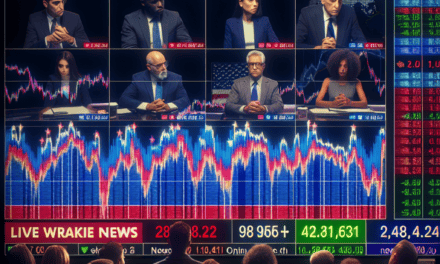“Revitalized Growth: Emerging Markets Surge on China Stimulus and Post-Election Optimism”
Introduction
Emerging market assets have experienced a notable rebound, driven by renewed optimism surrounding China’s economic stimulus measures in the wake of the recent U.S. election. Investors are increasingly confident that China’s proactive fiscal and monetary policies will bolster growth prospects, providing a much-needed boost to global markets. This optimism is further amplified by the potential for improved trade relations and geopolitical stability following the U.S. election results. As a result, capital flows into emerging markets have surged, with equities, currencies, and bonds all witnessing significant gains. This resurgence underscores the interconnectedness of global economies and the pivotal role of major policy shifts in shaping market dynamics.
Impact Of China’s Stimulus On Emerging Market Assets
The recent rebound in emerging market assets has been significantly influenced by renewed optimism surrounding China’s stimulus measures, particularly in the aftermath of the US election. This development has sparked a wave of interest among investors, who are keenly observing the interplay between these two major global events and their implications for emerging markets. As the world’s second-largest economy, China’s economic policies have far-reaching effects, and its recent stimulus efforts are no exception. These measures are designed to bolster domestic growth, stabilize financial markets, and enhance investor confidence, thereby creating a ripple effect that extends to emerging market assets.
In the wake of the US election, global markets experienced a period of uncertainty, with investors closely monitoring potential shifts in US foreign policy and economic strategy. However, as the dust began to settle, attention shifted towards China’s proactive approach to sustaining its economic momentum. The Chinese government has unveiled a series of fiscal and monetary policies aimed at stimulating growth, including infrastructure investments, tax cuts, and increased lending to key sectors. These initiatives are intended to mitigate the impact of global economic headwinds and ensure a stable growth trajectory.
The optimism surrounding China’s stimulus measures has been a boon for emerging market assets, which are often sensitive to changes in global economic conditions. As investors seek higher returns in a low-interest-rate environment, emerging markets present attractive opportunities due to their growth potential and relatively higher yields. The positive sentiment generated by China’s economic policies has led to increased capital inflows into these markets, driving up asset prices and enhancing liquidity.
Moreover, the interconnectedness of global supply chains means that China’s economic health is intrinsically linked to that of many emerging markets. As China ramps up its infrastructure projects and industrial output, demand for commodities and raw materials from emerging economies is expected to rise. This increased demand not only supports commodity prices but also boosts the export revenues of resource-rich countries, further strengthening their economic outlook.
In addition to the direct economic benefits, China’s stimulus measures have also contributed to a more favorable risk environment for emerging market assets. By stabilizing its own financial markets and signaling a commitment to growth, China has helped alleviate some of the geopolitical and economic uncertainties that have weighed on investor sentiment. This has encouraged a more risk-on approach among investors, who are now more willing to allocate capital to emerging markets.
However, it is important to note that while China’s stimulus measures have provided a much-needed boost to emerging market assets, challenges remain. The global economic landscape is still fraught with uncertainties, including potential shifts in US trade policy, ongoing geopolitical tensions, and the lingering effects of the COVID-19 pandemic. As such, investors must remain vigilant and consider the broader macroeconomic context when making investment decisions.
In conclusion, the rebound in emerging market assets can be largely attributed to the optimism surrounding China’s stimulus measures, which have provided a catalyst for increased investor interest and capital inflows. While the post-US election environment initially posed challenges, China’s proactive economic policies have helped restore confidence and create opportunities for growth in emerging markets. As the global economy continues to evolve, the interplay between major economic powers like China and the US will remain a key factor influencing the trajectory of emerging market assets.
Post-US Election: A New Dawn For Emerging Markets
In the wake of the recent U.S. elections, emerging market assets have experienced a notable rebound, driven by renewed optimism surrounding China’s economic stimulus measures. This resurgence comes at a time when global investors are recalibrating their strategies, seeking opportunities in markets that promise growth and stability amidst geopolitical shifts. The U.S. elections, a significant event on the global stage, have historically influenced market dynamics, and this year is no exception. However, the focus has shifted towards the East, where China’s proactive economic policies are instilling confidence among investors.
China, as the world’s second-largest economy, plays a pivotal role in the global economic landscape. Its recent commitment to bolstering economic growth through targeted stimulus measures has been a catalyst for the renewed interest in emerging markets. These measures, aimed at revitalizing domestic consumption and supporting key industries, are expected to have a ripple effect across the region. Consequently, investors are increasingly viewing emerging markets as attractive destinations for capital allocation, anticipating that China’s economic momentum will translate into broader regional growth.
Moreover, the post-election environment in the United States has introduced a degree of uncertainty, prompting investors to diversify their portfolios. The potential for policy shifts and regulatory changes under the new administration has led to a cautious approach towards U.S. assets. In contrast, emerging markets, buoyed by China’s stimulus efforts, offer a compelling alternative. This shift in investor sentiment is further supported by favorable economic indicators in several emerging economies, which are showing signs of recovery from the pandemic-induced downturn.
In addition to China’s influence, other factors are contributing to the positive outlook for emerging markets. Commodity prices, which are crucial for many emerging economies, have shown resilience, providing a boost to countries reliant on exports of raw materials. Furthermore, the global low-interest-rate environment continues to drive the search for higher yields, making emerging market assets more appealing. As central banks in developed economies maintain accommodative monetary policies, the yield differential between developed and emerging markets remains attractive, drawing in yield-seeking investors.
The interplay between these factors underscores the interconnectedness of global markets and the importance of strategic diversification. As investors navigate the complexities of the post-election landscape, emerging markets present a unique opportunity to capitalize on growth prospects that are less tethered to the uncertainties facing developed economies. However, it is essential to acknowledge the inherent risks associated with investing in these markets, including political instability and currency volatility. Therefore, a nuanced approach, balancing potential rewards with risks, is crucial for investors looking to tap into the emerging market resurgence.
In conclusion, the post-U.S. election period marks a new dawn for emerging markets, driven by optimism surrounding China’s economic stimulus measures. As global investors reassess their strategies in light of geopolitical shifts, emerging markets stand out as promising avenues for growth and diversification. The combination of China’s proactive policies, resilient commodity prices, and the global low-interest-rate environment creates a favorable backdrop for these markets. While challenges remain, the potential for robust returns makes emerging market assets an attractive proposition in the evolving global economic landscape.
How China’s Economic Policies Influence Global Markets
In recent years, the global economic landscape has been significantly influenced by the policies and economic maneuvers of major players like China. As the world’s second-largest economy, China’s economic policies have far-reaching implications, particularly for emerging market assets. The recent rebound in these assets can be attributed to a combination of factors, including optimism surrounding China’s stimulus measures and the aftermath of the US election. Understanding how China’s economic strategies impact global markets is crucial for investors and policymakers alike.
To begin with, China’s economic policies often serve as a barometer for global economic health. When China implements stimulus measures, it typically signals an intention to boost domestic growth, which can have a ripple effect on global markets. For instance, when China announces infrastructure spending or monetary easing, it often leads to increased demand for commodities and raw materials. This, in turn, benefits emerging markets that are rich in these resources, as they experience a surge in exports and economic activity. Consequently, investors tend to flock to these markets, driving up asset prices and contributing to a rebound.
Moreover, the timing of China’s stimulus measures in the context of the US election results has added another layer of complexity to the global economic outlook. The US election often brings about a period of uncertainty, as markets react to potential shifts in trade policies and international relations. However, with the election now concluded, there is a renewed focus on economic fundamentals. China’s proactive stance in implementing stimulus measures has provided a sense of stability and optimism, counterbalancing any lingering uncertainties from the US political scene.
In addition to direct economic impacts, China’s policies also influence global investor sentiment. When China demonstrates a commitment to maintaining economic stability and growth, it instills confidence in investors worldwide. This confidence is particularly crucial for emerging markets, which are often perceived as riskier investments. By signaling a robust economic outlook, China indirectly encourages investment flows into these markets, further supporting asset prices.
Furthermore, China’s role in global supply chains cannot be overlooked. As a major manufacturing hub, any changes in China’s economic policies can have significant implications for global trade dynamics. For example, if China decides to increase production or reduce tariffs, it can lead to a realignment of supply chains, benefiting countries that are integrated into these networks. Emerging markets, which often serve as key nodes in these supply chains, stand to gain from such policy shifts, as they experience increased trade volumes and economic growth.
It is also important to consider the broader geopolitical context in which China’s economic policies operate. As China continues to assert its influence on the global stage, its economic decisions are often intertwined with strategic considerations. This can lead to complex interactions with other major economies, such as the United States and the European Union, further impacting global markets. For emerging markets, navigating these geopolitical dynamics is essential to capitalizing on the opportunities presented by China’s economic policies.
In conclusion, China’s economic policies play a pivotal role in shaping global market trends, particularly for emerging market assets. The recent rebound in these assets, driven by optimism surrounding China’s stimulus measures and the post-US election environment, underscores the interconnectedness of global economies. As China continues to implement policies aimed at sustaining growth and stability, its influence on global markets is likely to remain a key factor for investors and policymakers to consider. Understanding these dynamics is essential for making informed decisions in an increasingly complex and interdependent world economy.
The Role Of US-China Relations In Emerging Market Recovery
Emerging market assets have recently experienced a notable rebound, driven by renewed optimism surrounding China’s economic stimulus measures and the evolving dynamics of US-China relations following the US election. This recovery underscores the intricate interplay between geopolitical developments and economic strategies, highlighting the significant role that US-China relations play in shaping the trajectory of emerging markets.
In the wake of the US election, global investors have been closely monitoring the potential shifts in US foreign policy, particularly concerning China. The election results have introduced a degree of uncertainty, yet they have also opened the door to potential recalibrations in diplomatic and economic engagements between the two superpowers. This evolving landscape has profound implications for emerging markets, which are often sensitive to the ebbs and flows of US-China relations.
China’s recent commitment to bolstering its economy through targeted stimulus measures has further fueled optimism among investors. These measures are designed to stabilize growth and enhance domestic consumption, thereby providing a buffer against external economic pressures. As China remains a pivotal player in the global supply chain, its economic health is intrinsically linked to the performance of emerging markets. Consequently, China’s proactive stance in stimulating its economy has been perceived as a positive signal, instilling confidence in investors and contributing to the rebound of emerging market assets.
Moreover, the potential for a more stable and predictable US-China relationship post-election has alleviated some of the geopolitical tensions that have previously weighed on emerging markets. A reduction in trade hostilities and a more collaborative approach to addressing global challenges could foster a more conducive environment for economic growth. This, in turn, would benefit emerging markets that are heavily reliant on trade and investment flows from both the US and China.
The interconnectedness of global markets means that any improvement in US-China relations can have a ripple effect, enhancing investor sentiment and encouraging capital inflows into emerging markets. These markets, characterized by their growth potential and relatively higher returns, become more attractive to investors seeking diversification and opportunities beyond developed economies. As a result, the stabilization of US-China relations could serve as a catalyst for sustained recovery and growth in emerging market assets.
However, it is important to acknowledge that the path to recovery is not without challenges. Emerging markets must navigate a complex landscape of domestic and international factors, including inflationary pressures, currency volatility, and potential shifts in monetary policy by major central banks. While the optimism surrounding China’s stimulus and improved US-China relations provides a supportive backdrop, emerging markets must remain vigilant and adaptable to changing conditions.
In conclusion, the rebound of emerging market assets is intricately linked to the evolving dynamics of US-China relations and China’s economic strategies. The post-election environment presents both opportunities and challenges, with the potential for improved diplomatic ties offering a glimmer of hope for sustained recovery. As investors continue to assess the implications of these developments, the role of US-China relations in shaping the future of emerging markets remains a critical factor to watch. Through careful navigation of this complex landscape, emerging markets can harness the potential benefits of a more stable global environment, paving the way for long-term growth and prosperity.
Investor Sentiment: Riding The Wave Of China’s Stimulus
In the wake of the recent U.S. elections, investor sentiment has experienced a notable shift, with emerging market assets witnessing a significant rebound. This resurgence is largely attributed to renewed optimism surrounding China’s economic stimulus measures. As investors navigate the complexities of the global financial landscape, the interplay between political developments in the United States and economic policies in China has become increasingly pivotal.
The U.S. elections, a focal point for global markets, have historically influenced investor behavior, often leading to periods of uncertainty and volatility. However, the recent electoral outcomes have provided a degree of clarity, allowing investors to refocus their attention on other critical factors, such as China’s economic strategies. In this context, China’s commitment to bolstering its economy through targeted stimulus measures has emerged as a key driver of positive sentiment in emerging markets.
China’s economic policies have long been a barometer for global economic health, given its status as the world’s second-largest economy. The Chinese government’s recent announcements of increased fiscal spending and monetary easing have been met with enthusiasm by investors, who view these measures as a catalyst for growth not only within China but also across emerging markets. This optimism is underpinned by the expectation that China’s stimulus efforts will lead to increased demand for commodities and other goods, thereby benefiting countries that are major exporters to China.
Moreover, the timing of China’s stimulus measures is particularly fortuitous for emerging markets, as it coincides with a period of relative stability in the U.S. political landscape. With the immediate uncertainties of the U.S. elections behind them, investors are now more inclined to seek opportunities in higher-risk, higher-reward markets. Emerging market assets, which often bear the brunt of global economic fluctuations, are now being viewed through a more favorable lens, as the potential for growth outweighs the risks associated with these investments.
In addition to China’s domestic policies, its role in global trade and investment flows cannot be overstated. As China continues to expand its Belt and Road Initiative and strengthen economic ties with other countries, emerging markets stand to benefit from increased infrastructure investments and trade partnerships. This interconnectedness further amplifies the positive impact of China’s stimulus measures on emerging market assets.
However, it is important to acknowledge that while the current wave of optimism is buoying emerging market assets, potential challenges remain. Geopolitical tensions, fluctuating commodity prices, and the ongoing impacts of the COVID-19 pandemic are factors that could temper investor enthusiasm. Nevertheless, the prevailing sentiment is one of cautious optimism, as investors weigh these risks against the backdrop of China’s proactive economic policies.
In conclusion, the rebound in emerging market assets, spurred by China’s stimulus optimism and the post-U.S. election landscape, highlights the intricate dynamics of global investor sentiment. As China continues to implement measures aimed at sustaining economic growth, emerging markets are poised to capitalize on these developments. For investors, the current environment presents a unique opportunity to ride the wave of optimism, while remaining vigilant to the potential challenges that lie ahead. Through careful analysis and strategic decision-making, investors can navigate this complex landscape and potentially reap the rewards of a resurgent emerging market sector.
Emerging Markets: Opportunities And Risks In A Post-Election World
In the wake of the recent U.S. elections, emerging market assets have experienced a notable rebound, driven largely by renewed optimism surrounding China’s economic stimulus measures. This resurgence comes at a time when global investors are recalibrating their strategies, seeking opportunities in markets that promise growth potential amidst a backdrop of geopolitical shifts. The interplay between the U.S. election outcomes and China’s economic policies has created a unique environment where emerging markets are poised to benefit, albeit with inherent risks that require careful navigation.
The U.S. elections have historically had a significant impact on global markets, influencing investor sentiment and capital flows. This year, the results have ushered in a period of relative stability, with expectations of continued economic cooperation and trade relations. Consequently, investors are increasingly turning their attention to emerging markets, which are often seen as barometers of global economic health. The prospect of a stable U.S. administration has alleviated some of the uncertainties that previously weighed on these markets, allowing them to capitalize on favorable external conditions.
Simultaneously, China’s commitment to bolstering its economy through targeted stimulus measures has further fueled optimism. As the world’s second-largest economy, China’s policies have far-reaching implications for emerging markets, many of which are closely tied to its economic fortunes. The Chinese government’s focus on infrastructure development, technological innovation, and domestic consumption is expected to create a ripple effect, benefiting countries that supply raw materials and components to China. This interconnectedness underscores the importance of China’s economic trajectory in shaping the prospects of emerging markets.
Moreover, the combination of a stable U.S. political landscape and proactive Chinese economic policies has led to a resurgence in investor confidence. Capital inflows into emerging markets have increased, as investors seek to diversify their portfolios and tap into higher growth rates compared to developed economies. This influx of capital is crucial for these markets, as it provides the necessary resources for development and expansion. However, it is essential to recognize that this optimism is not without its challenges.
While the current environment presents opportunities, emerging markets are not immune to risks. Currency volatility, political instability, and regulatory uncertainties remain persistent concerns that can undermine investor confidence. Additionally, the potential for a slowdown in China’s economic growth or a shift in U.S. foreign policy could quickly alter the landscape, necessitating a cautious approach. Investors must remain vigilant, balancing the allure of high returns with the need for risk management strategies.
In conclusion, the post-U.S. election period has ushered in a wave of optimism for emerging market assets, buoyed by China’s economic stimulus measures. The interplay between these two global powerhouses has created a favorable environment for growth, attracting investors seeking diversification and higher returns. However, the inherent risks associated with emerging markets necessitate a prudent approach, as geopolitical and economic uncertainties continue to loom. As the world navigates this complex landscape, the ability to adapt and respond to changing dynamics will be crucial for investors aiming to capitalize on the opportunities presented by emerging markets in this post-election world.
Analyzing The Rebound: Key Factors Driving Emerging Market Growth
Emerging market assets have recently experienced a notable rebound, driven by a confluence of factors that have invigorated investor confidence. Central to this resurgence is the optimism surrounding China’s latest stimulus measures, which have been perceived as a catalyst for growth in these markets. This development comes in the wake of the recent U.S. elections, which have also played a significant role in shaping the investment landscape. As we delve into the key factors driving this growth, it is essential to understand the interplay between these global events and their impact on emerging markets.
To begin with, China’s decision to implement robust stimulus measures has been a pivotal factor in the renewed interest in emerging market assets. The Chinese government has unveiled a series of fiscal and monetary policies aimed at bolstering economic growth, which has been sluggish due to various internal and external pressures. These measures include increased infrastructure spending, tax cuts, and enhanced credit support for businesses. As China is a major trading partner for many emerging economies, its economic health is intrinsically linked to their performance. Consequently, the stimulus has instilled a sense of optimism among investors, who anticipate that increased Chinese demand will have a positive ripple effect across emerging markets.
In addition to China’s stimulus, the outcome of the U.S. elections has also contributed to the rebound in emerging market assets. The elections have brought about a degree of political stability and clarity, which has been welcomed by investors. The prospect of a more predictable U.S. foreign policy and trade relations under the new administration has alleviated some of the uncertainties that previously weighed on emerging markets. Furthermore, the potential for a more accommodative monetary policy stance by the U.S. Federal Reserve, in response to the new administration’s economic agenda, has led to a weaker U.S. dollar. A depreciating dollar is generally favorable for emerging markets, as it reduces the burden of dollar-denominated debt and makes their exports more competitive.
Moreover, the global economic recovery from the pandemic-induced downturn has also played a crucial role in the resurgence of emerging market assets. As vaccination rates increase and economies reopen, there is a growing demand for commodities and goods produced by emerging markets. This demand has been further amplified by supply chain disruptions in developed economies, prompting companies to diversify their sourcing and production to emerging markets. As a result, these markets are experiencing increased capital inflows, which are bolstering their currencies and stock markets.
However, it is important to acknowledge the risks that could potentially derail this growth trajectory. Geopolitical tensions, particularly between major powers, could pose a threat to the stability of emerging markets. Additionally, any abrupt changes in U.S. monetary policy could lead to capital outflows and increased volatility. Therefore, while the current outlook is positive, investors must remain vigilant and adaptable to changing circumstances.
In conclusion, the rebound in emerging market assets is being driven by a combination of China’s stimulus measures, the impact of the U.S. elections, and the broader global economic recovery. These factors have collectively fostered an environment conducive to growth, attracting investors seeking higher returns. As emerging markets continue to navigate these dynamic conditions, their ability to capitalize on these opportunities will be crucial in sustaining this upward momentum.
Q&A
1. **Question:** What are emerging market assets?
– **Answer:** Emerging market assets refer to financial instruments such as stocks, bonds, and currencies from developing countries that are experiencing rapid growth and industrialization.
2. **Question:** How does China’s stimulus impact emerging market assets?
– **Answer:** China’s stimulus can boost emerging market assets by increasing demand for commodities and exports from these markets, improving investor sentiment, and enhancing economic growth prospects in these regions.
3. **Question:** Why is there optimism about China’s stimulus measures?
– **Answer:** Optimism about China’s stimulus measures stems from expectations that increased government spending and monetary easing will spur economic growth, benefiting both China and its trading partners.
4. **Question:** How might the US election impact emerging market assets?
– **Answer:** The US election can impact emerging market assets through changes in trade policies, geopolitical relations, and investor risk appetite, potentially leading to increased volatility or stability in these markets.
5. **Question:** What role does investor sentiment play in the rebound of emerging market assets?
– **Answer:** Investor sentiment plays a crucial role as positive outlooks on economic policies and global growth can lead to increased capital inflows into emerging markets, driving asset prices higher.
6. **Question:** Which sectors in emerging markets are likely to benefit most from China’s stimulus?
– **Answer:** Sectors such as commodities, manufacturing, and technology in emerging markets are likely to benefit most from China’s stimulus due to increased demand and investment.
7. **Question:** What are the risks associated with investing in emerging market assets during a rebound?
– **Answer:** Risks include political instability, currency fluctuations, changes in global interest rates, and potential reversals in investor sentiment, which can lead to increased volatility and potential losses.
Conclusion
The rebound of emerging market assets following optimism around China’s stimulus measures and the impact of the US election highlights the interconnectedness of global economies. China’s stimulus efforts are seen as a catalyst for growth, boosting investor confidence in emerging markets that are closely tied to China’s economic performance. Additionally, the outcome of the US election can influence global trade policies and investor sentiment, further affecting emerging markets. The combination of these factors suggests a potential for increased capital flows into emerging markets, as investors seek higher returns amid a supportive global economic environment. However, the sustainability of this rebound will depend on the effective implementation of China’s stimulus measures and the stability of US economic policies post-election.





